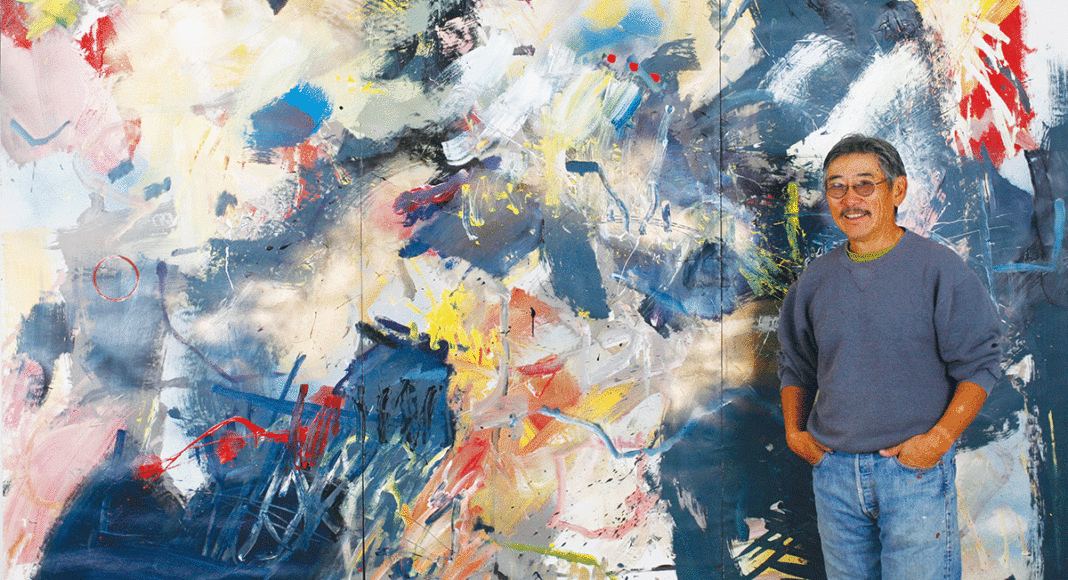Roughly 20 years ago, I spent an afternoon with the celebrated artist and beloved Cabrillo College instructor Howard Ikemoto at his Eastside Santa Cruz studio, discussing the work that he was assembling for a show entitled “Chi: A Family Divided,” a collection that both chronicled and explored the devastating impact that World War II had imposed on his family and his young childhood.
“I’m still coming to terms with it all,” he said at the time. “And it’s still very painful.” He was 57 then, in the waning years of the 20th century, and though the time period he was processing seemed like long ago, he acknowledged that it still felt very much present. I could feel his discomfort at reliving the painful memories of his youth.
I first met Ikemoto when I was still in high school, in the early 1970s, and from that initial encounter, I found him to be something of an older-brother figure—quiet and respectful, yes, but also very powerful with a deep inner reserve that had been forged by a life both literally and figuratively lived close to the flames, though not always by his own choice.
That power and strength were reflected not only in the works that comprised “Chi: A Family Divided,” but in his entire oeuvre. And it is those qualities that are center stage in what is being dubbed as Ikemoto’s “Last Show,” to be held at the Cabrillo College Gallery (in the Library Building), this coming Friday through Sunday (June 2-4), from noon to 5 p.m.
The exhibition (and sale) of Ikemoto’s life work—coordinated by Jeanne Ikemoto, the artist’s wife of 24 years and mother of his two daughters, Ami Ikemoto and Reiko Joseph—includes dozens of pieces ranging from small drawings, to prints, watercolor landscapes and large-scale impressionistic oils. The exhibit also includes some remaining works from “Chi: A Family Divided.” It’s a remarkable collection.
The one element missing—and hence the title of the exhibit—is Ikemoto himself. Four years ago, he was diagnosed with acute dementia, and he is now confined to a residential treatment center in Southern California. His spirit, however, is present in every piece on display, along with his intense artistic vision.
Ikemoto was born into a Japanese-American family in Sacramento that earned its way in the waning days of the Great Depression by farming the rich soils of the Central Valley and running a small grocery store and hotel.
It was in the fall of 1940—still more than a year before the U.S. joined World War II—that an employee from the McClellan Air Force Base walked into the Ikemoto store and boldly announced to Ikemoto’s father that the so-called “dummy” bombs used by the Air Force planes at McClellan were being replaced by the real thing. “If Japan and America get into a war,” he added menacingly, “I’m coming back to kill you and your family.”
That threat would have a profound impact on Ikemoto’s parents and his six siblings for the rest of their lives. Worried about the impending war and the growing hostility directed at Japanese Americans in the Sacramento Valley, Ikemoto’s father decided to send his three eldest children to live with his parents in the small village of Shozuko, on the main island of Honshu, only 30 miles from Hiroshima, where the first atomic bomb was dropped in August of 1945. They weren’t allowed to reunite with their family in the U.S. until the early 1950s.
Back in Sacramento, the remaining members of the Ikemoto clan were facing a terrifying, surreal ordeal of their own. In May of 1942, the Ikemotos—including their three-year-old son Howard—were declared “enemy aliens” and sent off to the Tule Lake concentration camp, near the California-Oregon border, where they were to remain imprisoned by their own government until the spring of 1946.
One of the ways that Ikemoto confronted this dark personal history, he told me, was by drawing. And since he spoke only Japanese prior to reentering elementary school after the war, art provided him with a means of communication. He later studied art at Sacramento City and San Jose State colleges, and shortly thereafter began his teaching career at Cabrillo, first in 1966, and after a few years of soul-searching in Japan, again in 1970. He emphasized to me that he considered teaching an art form, too.
The legion of students who respected, admired and were inspired by Ikemoto remain part of his legacy, along with his art. “We call the exhibit a benefit toward Howard’s care,” says Jeanne Ikemoto, “but I’ve realized that the overwhelming show of support for the exhibit has made it a benefit for the community, too. It’s a way of bringing people together whom Howard impacted through his teaching. And the sale allows people to keep a little piece of Howard with them. The hope is that we find a home for every piece of Howard’s work.”
INFO: ‘Howard Ikemoto: The Last Show’ runs Friday thru Sunday, June 2-4, noon to 5 p.m. at Cabrillo College Gallery, Cabrillo College, Library Building, 6500 Soquel Drive, Aptos. For further information call 831-479-6308 or go to howardikemoto.com.














I love Howard Ikemoto’s work and hope to go to the exhibit today! He is a profoundly charming and intelligent artist who has been very generous to fellow artists, not only his students. He is one of the best–a remarkable human being!